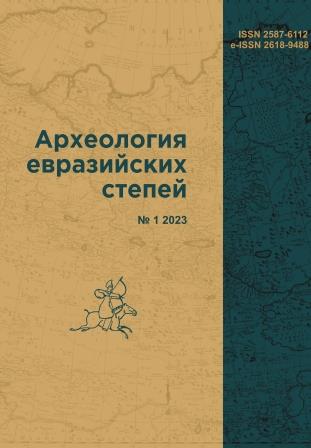The Sukhona–Vychegda Way During the Middle Ages: on the question of economic and ethnic-cultural contacts of the Permian Urals with ancient Russia
DOI:
https://doi.org/10.24852/2587-6112.2023.1.100.106Keywords:
archaeology, Sukhona-Vychegda trade route, Permian Urals, Old Russia, economic ties, ethnic-cultural ties.Abstract
The article presents the results of an archaeological study of the Sukhona-Vychegda Rivers trade route connecting the North of Ancient Russia and the Permian Urals. The basis of the study consists of the finds of ancient Russian products found during the excavations of the Novgorod lands, Ladoga region, the territory of Perm Vychegodskaya, Udmurt Urals and the Kama region. The Sukhona-Vychegda way began from Novgorod along the Syas River, or from the Ladoga region along the Svir River or the Oyat, to the Beloe Lake. Further this route passed along the Sukhona and Vychegda Rivers to the basin of the Pechora River, with a branch to the Permian Urals. Among the forms of mutual relations of the tribes inhabiting the territories through which the Sukhona-Vychegda way passed, the author highlights trade, cultural influence, marital ties and the penetration of the population into neighboring territories. Along the trade route from the territory of Ancient Russia, the following items fell into the Kama region: twisted rings (XI–XIII centuries), ribbed rings (XI–XIV centuries), cross-cut pear-shaped bells (end of the X – beginning of the XII centuries.), Christian crosses (XI century.), oblique coin-shaped pendants (XII–XIV centuries), Western European denarii.
References
Belavin, A. M. 2000. Kamskii torgovyi put’. Srednevekovoe Predural’e v ego ekonomicheskikh I etnokul’turnykh sviaziakh (Kama Trade Route: Medieval Cis-Urals in its Economic and Cultural Relations). Perm: Perm State Pedagogical University (in Russian).
Boguslavsky, O. I. 1993. In Masson, M. V. (ed.). Drevnosti Severo-Zapada Rossii (slavyano-finno-ugorskoe vzaimodeystvie, russkie goroda Baltiki) (Antiquities of the North-West of Russia (Slavic-Finno-Ugric interaction, Russian urban settlements in the Baltic Sea region)). Saint Petersburg: “Peterburgskoe vostokovedenie” Publ., 132–157 (in Russian).
Golovchansky, G. P. 2006. Khristianizatsiya Permi Velikoy v XV – nachale XVIII vv. (Christianization of Great Perm in the XV – early XVIII centuries). Diss. of Candidate of Historical Sciences. Perm (in Russian).
Golovchansky, G. P., Melnichuk, A. F. 2018. In Vestnik Permskogo universiteta. Seriia Istoriia (Bulletin of the Perm University: History Series) (1), 101–111 (in Russian).
Ivanov, A. G. 1998. Etnokul’turnye i ekonomicheskie sviazi naseleniia basseina r. Cheptsy v epokhu srednevekov’ia (konets V – pervaia polovina XIII v.) (Ethnic, Cultural and Economic Relations of the Cheptsa River Basin Population in the Middle Ages (Late 5th — First Half of 13th Centuries)). Izhevsk: Udmurt Institute for History, Language, and Literature, Russian Academy of Sciences, Ural Branch (in Russian).
Korolkova, L. V.1999. Severo-vostochnye rayony Novgorodskoy zemli X–XVII vekov. Formirovanie seti rasseleniya i etnokul'turnye vzaimodeystviya (North-Eastern territories of the Novgorod Land in the X–XVII centuries. Formation of a settling network and ethnic-cultural interactions). Saint Petersburg (in Russian).
Korchagin, P. A., Lobanova, A. S. 2012. In Vestnik Permskogo universiteta. Seriia Istoriia (Bulletin of the Perm University: History Series) 18 (1), 121–134 (in Russian).
Moryakhina, K. V. 2016. In Alekshin, V. A. (ed.). Aktual'naya arkheologiia 3. Novye interpretatsii arkheologicheskikh dannykh) (Topical archaeology: new interpretations of archaeological data) 3 Saint Petersburg: Institute for the History of Material Culture, Russian Academy of Sciences, 281–284 (in Russian).
Riabinin, E. A. 1997. Finno-ugorskie plemena v sostave drevnei Rusi (Finno-Ugric Tribes as a Part of Ancient Rus). Saint Petersburg: Saint Petersburg State University (in Russian).
Savel'eva, E. A. 2013. In Vaskul, I. O. (ed.). Etnokul'turnye kontakty v epokhu kamnia, bronzy, rannego zheleznogo veka i srednevekov'ia v Severnom Priural'e (Ethnic-Cultural Relations of the Population of the European North-East in Antiquity and the Middle Ages). Series: Materialy po arkheologii Evropeiskogo Severo-Vostoka (Materials on the Archaeology of the European North-East) 18. Syktyvkar: Institute of Language, Literature and History, Komi Research Center, Ural Branch of the Russian Academy of Sciences, 8–21 (in Russian).
Savel'eva, E. A. 2021. In Vestnik Permskogo universiteta. Seriia Istoriia (Bulletin of the Perm University: History Series) 52 (1), 70–80 (in Russian).
Savel'eva, E. A. 2021. In Izvestiia Komi nauchnogo tsentra UrO RAN. (Proceedings of the Komi Scientific Center, Ural Branch of the Russian Academy of Sciences) (4), 13–24 (in Russian).
Savel’eva, E. A., Klenov, M. V. 1997. In Savel’eva, E. A. (ed.). Arkheologiia Respubliki Komi (Archaeology of the Komi Republic). Moscow: “DiK” Publ., 651–691 (in Russian).
Malm, V. A., Fekhner, M. V. 1967. In Rybakov, B. A. (ed.). Ocherki po istorii russkoi derevni X–XIII vv. (Sketches on History of the Russian Village of 10th—13th Centuries). Series: Trudy Gosudarstvennogo istoricheskogo muzeia (Proceedings of the State Historical Museum) 43. Moscow: “Sovetskaia Rossiia” Publ., 133–149 (in Russian).

Downloads
Published
How to Cite
Issue
Section
License
Copyright (c) 2023 V.E. Kuznetsov

This work is licensed under a Creative Commons Attribution-NonCommercial 4.0 International License.







